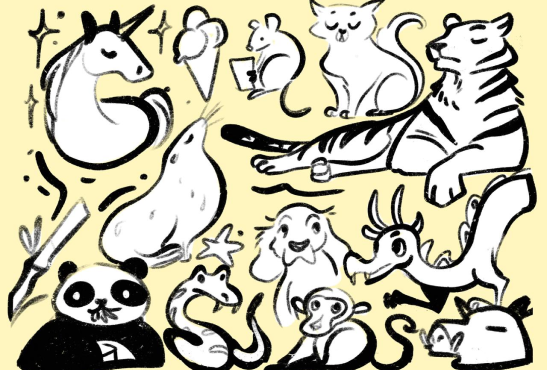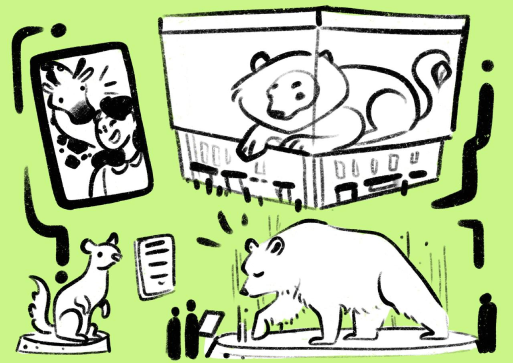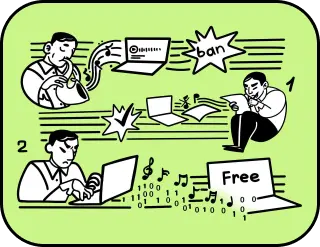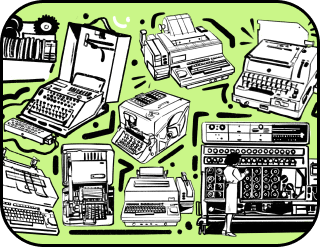How to find and tame your totem animal
In a small town where technology intertwines with nature, residents began noticing unusual things: every time someone faced a difficult task or encountered a crisis, a cute baby owl would appear in their life. This owl became the town’s totem animal, symbolizing wisdom, helping people find solutions in challenging situations.
Various legends provide simple explanations for such phenomena, and it even has its own name — “Egregor” – a magical bio-field created by the thoughts of a group of people. Throughout the ages, humanity has created egregors of totem animals, and these energy clusters embodied the characteristics of various creatures: from graceful birds to nimble insects. Totem animals cannot literally jump like a hare or flutter like a dove, but they can offer strength for solving specific problems in the physical world.
The same legends say that a totem cannot be assigned; it must be discovered within oneself. But where to find this wondrous treasure in the world of digital technologies? On the one hand, totem animals are symbols that connect a person with nature; on the other hand, virtual zoos and digital platforms offer the opportunity to interact with such symbols in a new technological format, creating an illusion of closeness to wildlife while distancing us from its true essence.
We offer you two solutions that will help you find your totem talisman, but whether you should adopt one or always rely on your own strength is up to you.
Sometimes, it’s so tempting to wish for a unicorn to suddenly appear and offer ice cream! Or a dragon to instantly solve all the accumulated problems. So why not turn to the ancient Chinese and their passion for astrology? Looking into the Chinese zodiac can evoke a whole range of emotions: “Oh, the zodiac is filled with a collection of eccentric personalities with temperaments that could rival any reality show!”
The true queen of the network is the Rat — a predator in the business world. At least, that’s what’s written in the Chinese book. These long-tailed “influencers” always know where to find treats, they’re aware of all the gossip, and the secrets of their success stir envy even in the Matrix itself!
The Tiger — a bold and charismatic beauty, capable of challenging the fiercest lions. When Tigers decides to take a risk, they do it with flair, even if it’s just a leap off the couch. Borderline adventures — that’s their element.
The master of feng shui and the true owner of space — the meowing cat. They easily manage everything, leaving those who don’t interest them out of the game. The chances of defeating them are minimal, but admiration for them only grows.
The Dragon — a mysterious creature, an entire epic encapsulated in fiery charisma. If you need scale, the Dragon will always show you how to achieve it. If you need the “element of success,” there are many opportunities — either within you or, quite likely, in the Dragon’s pocket!
The totem of loyal friendship and devotion — the Dog. They are incapable of deceitful deeds and will always remind you of changes in your surroundings.
The most optimistic hero of the astrological zoo — the Boar. The Bears’ philosophy is simple: “Live here and now.” They will always find time for a snack and happily share it with friends. Their optimism can lift even the most untrained moose, guiding it through shopping trips and leaving them in a cheerful mood.
The main beauty of the Chinese zodiac is the Monkey, whose appearance brings wisdom, intelligence, and depth into the lives of Chinese sages, and not only them.
What should you do if your totem animal is not in the horoscope? Visit a zoo! Especially since there are so many now. Comparing zoos is like comparing apples to oranges, but the Singapore Zoo is truly a cosmic phenomenon. A zoo where there are no bars or cages, where more than two thousand animals live in their own zoo city, unaware that curious tourists are gathered around them.
Perhaps your totem animal is hiding in the night safari. In that case, to find it, you’ll need to sneak through bamboo thickets and spy on how an awkward panda devours its lunch — a sight worth its weight in gold! You can really get close to the locals and take the opportunity to have breakfast with orangutans, lunch with a lemur, and of course, treat a giraffe to your dinner.
The zoo in New Jersey is affectionately called “Popcorn Park.” Here, abandoned, injured, and even elderly animals have found refuge, looking for a cozy place for a peaceful life. All the animals in this zoo have been given a second chance, and here you can witness their amazing “restart” of life. Perhaps it is in this zoo that you will discover a creature close to your spirit, as the pain of fate unites without words or natural affiliation.
And don’t forget about the caves in Oregon — the only place on the mainland where northern sea lions hibernate. Their friend, winter, knows how to add a little fun and mischief to life. The animals here will surely teach you what it means to enjoy life!
The world of the Bible is also full of animals that could serve as totems. Here, the Serpent is a symbol of temptation. This cunning and agile totem reminds us that behind every temptation lies a lesson. And what about the amazing two-level park, where trees and shrubs pose for selfies in the “Biblical classic” style, and the artificial “Moses’ Wall” stands bewildered, waiting for someone to explain how it ended up there? A wooden exhibit in the shape of a boat — Noah’s Ark, a true legend about animals that fled just before the zoological apocalypse. Among them, there were surely some that could serve as totems.
Perhaps the creature closest to your spirit is right next to you — half human, half animal. Maybe your totem is a stately centaur, or a funny quadruber.
A quadruber is a mix of a square and a horned bear, with a touch of artistic design. In the world of virtual creatures, they have become synonymous with bright individuality, absurd design, and broken code, because they are capable of doing things that seem more than strange to simple bipeds.
Friendly quadrubers as totem animals are a fun way to lift your spirits and look at life from an unconventional perspective. Who said you must take the selection of a totem seriously? After all, laughter is also a totem, just in the form of quantum horns!

In search of your totem animal, you can step outside, especially since the times when a lion might descend from the roof or the flexible body of a snake might appear — have returned. Huge 3D installations rise above the gates of medieval towers and subway stations. Animals literally “emerge” from the screen to the viewer. These media screens operate based on “naked eye” technology — a special video mapping technology on the facades of large objects that allows viewers to see a realistic 3D image without special glasses.
Back in 2014, when augmented reality technologies were just beginning to gain popularity, the staff at the Tokyo Sunshine Aquarium decided to implement an innovative technology to help visitors navigate the zoo in the urban jungle and not get lost along the way. Many people believe that augmented reality belongs only in smartphones, but this is not quite true. For over ten years, AR technologies have been actively used on large screens in various locations: on stages, city squares, in shopping malls, and, of course, in zoos.
The principle of operation of such an installation is quite simple: users are filmed in real time by a camera located above the screen, and they see themselves standing at a specific point. Special software overlays a virtual image onto the camera feed on the screen, seamlessly integrating it into the current location. Thus, users sees both themselves and objects from augmented reality, and in some cases, they can even interact with them. Along with geolocation AR, motion capture technology (“mocap”) is also used to create content.
Zoos and amusement parks around the world love using such technologies because they allow them to showcase large virtual objects in full size. Moreover, this is very effective and completely safe for both visitors and animals.
For example, a thrilling 7D virtual reality zoo has opened in Japan. It sounds incredible — living animals, ready to tickle your pockets and nerves! Holograms that look so realistic, it’s impossible to distinguish them from real animals, unique living conditions for many wild species, and every detail is thought out to the smallest detail. You can find yourself in impenetrable jungles, then immediately marvel at the mesmerizing underwater world, and in a second, you’ll be in the endless desert. To make this virtual reality even more convincing, special smells and sound effects are added. Searching for a totem animal has never been so exciting!
Now, welcome to the futuristic world of Hologram Zoo — an incredible holographic zoo in Australia, where technology has advanced even further. Imagine this: you’re running from frightened elephants, peering into the wide mouth of a hippopotamus, and gently petting a giraffe — all without leaving a single hall.
This zoo captivates with 50 incredible holograms, from prehistoric dinosaurs to cute gorillas, created using powerful lasers. The creator of this fantastic wonder, Bruce Dell, claims that this is the most cutting-edge place on the planet for animal lovers, where science fiction-worthy technologies literally come to life before the viewers’ eyes.
“Here, the atmosphere is one of fun and excitement… but when a 30-meter whale glides by, everyone suddenly freezes, feeling a reverent awe before such a magnificent creature, as if witnessing a grand spectacle of nature.”
At Hologram Zoo, augmented reality has been developed to transform the stage into a masterpiece using a special holographic screen, invisible to the naked eye. Under powerful projectors, virtual characters come to life, creating a magical fusion of animation and real action. The technologies that illuminate Hologram Zoo on the outskirts of Brisbane aren’t limited to just one place. They have already gained recognition in other fields: companies like Airbus and Honeywell are in talks with them, and soon, a holographic aquarium will open its transparent arms to visitors at a luxury hotel in the Maldives.
In a world where climate change and natural disasters are becoming commonplace, and ecology requires urgent action, a new concept has emerged — the Vertical Zoo. This futuristic utopia offers animals a sanctuary in increasingly hostile conditions.
Architects from Weston Williamson+Partners, inspired by post-apocalyptic themes, presented a project that looks like a giant tree piercing the clouds. Imagine this: you ride a glass elevator, and around you is greenery, light, and life. Animals and potential totem animals move freely along the branches, enjoying their freedom, while you observe them from above. A special covered greenhouse is provided for butterflies and insects, where they can flutter in conditions as close as possible to their natural habitat.
This is no longer just a zoo; it’s hope for preserving biodiversity in a world where nature needs protection. A place where the future of fauna and flora takes on new life, and we, humans, can witness this incredible process.
Soon, in the zoos of the future, we may encounter amazing robot animals, created in the image and likeness of real ones, or even clones of long-extinct creatures that once roamed our planet. At Canisius College in Buffalo, New York, a conference was held to discuss the implementation of this idea: “Robotics has already become a part of our everyday life — from robotic vacuum cleaners to smart operating systems. Why not introduce robots into zoos?”
Conference participants tried to imagine how such a robotic zoo might operate: some considered the approach to animal demonstrations exciting, while others doubted whether people would be interested in watching robots, even if they looked as realistic as possible. For example, one could ride on a robotic shark or a cave-dwelling robotic bear, not to mention taking a souvenir photo. If there are skeptics who believe that even the most realistic robots won’t attract people the way live animals do, they are likely to be in the minority.
Cloning technologies will allow us to bring extinct species back to life, those that are more suited to our time. By the way, the mammoth — a powerful totem — is the first candidate for “resurrection.” In the permafrost, like in a freezer, the bodies of the largest land mammals have been preserved, so isolating their DNA is not a difficult task.
Scientists already have tissue samples from the dodo, the wandering pigeon, the mastodon, and even the Tasmanian tiger, the last of which went extinct in the 1930s. All of these amazing creatures can be restored through cloning in the future.
But that’s not all! In the near future, we might have the opportunity to look into the minds of animals with the help of unique devices that read electroencephalograms. “This will help us better understand wolves or dolphins,” say experts. However, it’s likely that our pets will be the first to experience the full benefits of modern technology.
Thanks to brilliant inventors from the Scandinavian Society for Invention and Discovery (NSID), we will be able to see a device that can decode the basic thoughts of animals and translate them into signals we can understand.
Unlike traditional devices that use electroencephalographic sensors to analyze brain activity, the new device, called “No More Woof,” will take into account the pet’s psychological states: fatigue, joy, hunger, excitement, and more. The information gathered by the sensors will be processed by a microcomputer and played through a speaker, vocalizing the main desires of your pet.
Once the “No More Woof” thought reader is fully developed, it will be available in three versions: from the basic one that detects a few main thoughts to more advanced modifications. Indeed, why not ask the totem itself if it wants to be your talisman?
Ultimately, the decision to choose a totem animal or take fate into your own hands is a personal one: some may adopt an animal from a shelter and save a life, while others may feel perfectly comfortable with a robotic friend. The important thing is that we have the choice.

The Einstein-Rosen bridge? We’re building it out of facts.
Thank you!




